Vietnam - Hanoi Connection - Thit Cho - Thit Meo.
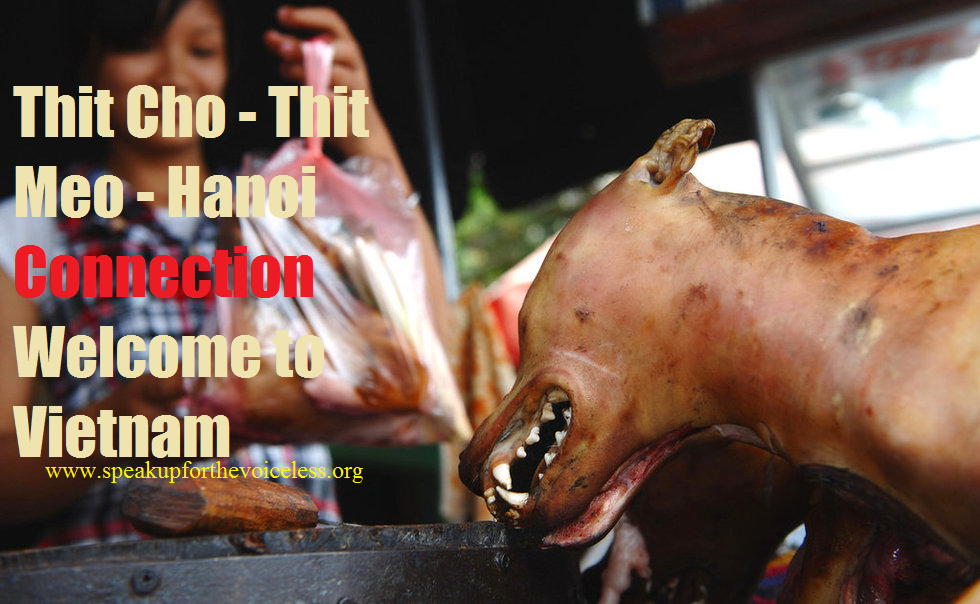 Hoang Giang, Hanoi, Vietnam. Two years ago I found myself on an assignment investigating the wildlife trade deep within Vietnam within the cites of Saigon and Hanoi. Dog meat (thit cho) and cat meat (thit meo) eaten as a prime delicacy within Vietnam is located just about on every street corner within many restaurants and street vendors. Trade is large and smuggling is big business from Thailand into Vietnam from Laos. The stench of rotting flesh and unhygienic premises is enough to turn anyone of food forever, however the true exposure of this trade must be exposed continuously and those without a voice must be heard. Welcome to Vietnam a dog and cats true nightmare a tale of barbaric, gross animal abuse and mis-justice, No animal is safe here, even the locals that do not consume the “delicacy” that own pets dare not allow their dog or cat to venture out into the streets in fear they too could be snatched by smuggling gangs thus ending up on some diners plate the next day.
Hoang Giang, Hanoi, Vietnam. Two years ago I found myself on an assignment investigating the wildlife trade deep within Vietnam within the cites of Saigon and Hanoi. Dog meat (thit cho) and cat meat (thit meo) eaten as a prime delicacy within Vietnam is located just about on every street corner within many restaurants and street vendors. Trade is large and smuggling is big business from Thailand into Vietnam from Laos. The stench of rotting flesh and unhygienic premises is enough to turn anyone of food forever, however the true exposure of this trade must be exposed continuously and those without a voice must be heard. Welcome to Vietnam a dog and cats true nightmare a tale of barbaric, gross animal abuse and mis-justice, No animal is safe here, even the locals that do not consume the “delicacy” that own pets dare not allow their dog or cat to venture out into the streets in fear they too could be snatched by smuggling gangs thus ending up on some diners plate the next day.
Please sign the petition lower down in the photo link or here. Please sign Say No To Dog Meat.Net’s second petition here.
The true horror of the Vietnamese pet meat trade is being attacked at every angle by Animal Rights Activists, Conservationists and overseas petitions calling the President of Vietnam Tru’o’ng Tan Sang to ban the trade immediately and end this horrific non-medicinal practice.
Trade History;
Every year hundreds of thousands of dogs and cats are snatched in Thailand then smuggled into Vietnam. The demand is so lucrative that stopping this trade is going to take “years” rather than months to stop. Down the leafy streets of north Hanoi’s Cau Giay district, not far from Nguyen’s family business, sits one of the city’s most famous restaurants, Quan Thit Cho Chieu Hoa, which has only one thing on the menu. There’s dog stew, served warm in a soup of blood; barbecued dog with lemongrass and ginger; steamed dog with shrimp-paste sauce; dog entrails sliced thin like sausage; and skewered dog, marinated in chilli and coriander. This is just one of a number of dogmeat restaurants in Cau Giay, but it is arguably the most revered, offering traditional dishes in a quiet setting along a canal. “I know it seems weird for me to eat here when I have my own dogs at home and would never consider eating them,” says Duc Cuong, a 29-year-old doctor, as he wraps a sliver of entrails in a basil leaf and takes a bite. “But I don’t mind eating other people’s dogs.” He swallows and clears his throat. “Dog tastes good and it’s good for you.” No one knows exactly when the Vietnamese started eating dog, but its consumption – primarily in the north – underlines a long tradition. And it is increasingly popular: activists claim up to 5 million of the animals are now eaten every year. Dog is the go-to dish for drinking parties, family reunions and special occasions. It is said to increase a man’s virility, warm the blood on cold winter nights and help provide medicinal cures, and is considered a widely available, protein-rich, healthy alternative to the pork, chicken and beef that the Vietnamese consume every day. 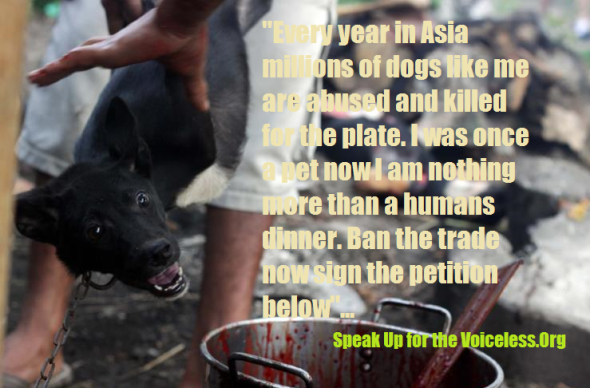
PLEASE SUPPORT SOI DOGS BY PROMOTING THE SHADOW TRADE ABOVE AND ENCOURAGING ALL MEDIA SPECIALISTS TO NOW PROMOTE - WE CANNOT SAVE EVERY SINGLE DOG BUT WE’LL DAMN WELL TRY.
As with the Rhino horn trade there is to date no proven medical literature to prove dog or cat meat holds any form of medical active properties yet people still continue to eat the meat of dog and cat. Dog and cat meat is normally consumed in the north rather than the south of Vietnam. International Animal Rescue Foundation’s Malaysian Environmental and Animal Welfare officer Arissa Lan Li questioned a trade dealer this year of which stated cats were used to protect their rice harvests from rodents. The trader then explained that cats seen then as a more good luck pet then multiplied thus causing hygiene and over populations concerns. “Cats were becoming quite an issue within the city the trader stated, so many locals then went back to dog ownership of which they used the dogs to chase feral cats away”.
Whether this is actually true we ourselves do not know, however in the north there are more paddy fields and harvests than in the south of which rice harvests are colossal and form part of Asia’s staple diet. Rice fields in Vietnam (ruộng or cánh đồng in Vietnamese) are the predominant land use in the valley of the Red River and the Mekong Delta. Dogs then became problematic in the north of which it is believed the trade in dog and cat meat then took off to control both overpopulations. Rodents adversely affect rural families in three main ways: they eat agricultural crops in the field; they eat, spoil and contaminate stored food; and they carry diseases of humans and their livestock. In the Asia–Pacific region, rodents are one of the most important constraints to agricultural production.
Management of rodent pests in agricultural regions is a high priority for reducing poverty. Arissa Lan Li questioned a dozen Vietnamese farmers of which explained more or less the same stories with regards to cats being used as rodent control. Many farmers questioned confirmed that cats then became more an issue thus seeing the introduction of dogs. Both dog and cats then became (cuisine) whilst Vietnamese locals fought hard to control over populations of both dogs, cats and rodents. According to statistics released by Binh Dinh’s Department of Agriculture and Rural Development, more than 1,000 ha of the winter-spring crops have been destroyed by rats. Evidence dating back to roughly 1969 shows that rodent control although problematic was under control however with cat meat consumption now on the rise rodents are now again taking over rice paddy fields again. 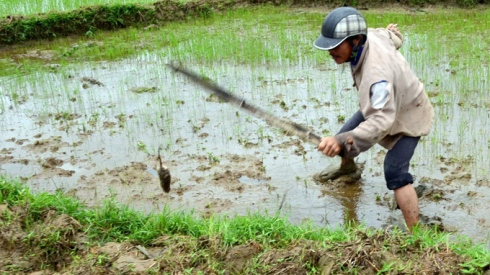 Picture above shows a Vietnam paddy farmer killing a rodent.
Picture above shows a Vietnam paddy farmer killing a rodent.
Since the reduction of cats now used in the meat trade rodent infestation has risen considerably. AFVN estimates that stray cats in rice fields kill approximately 400 mice per cat, each year and that cats do not have an adverse effect on the environment. As well as mice, rats have been infesting rice fields too. For a nation who dislikes cats, maybe cats are heaping back some revenge by in rice fields becoming overrun by rodents. Unlike western farmers that used high residual chemical rodent control - in Vietnam this was not an option due to high scale farming and harvests and the cost that surrounds “chemical” pest control. As explained we still do not know whether this is true and if a true date can actually be placed into the domain as to when the pet meat trade actually took of in Vietnam. From looking at all evidence though it appears that the pet trade within “Vietnam” being a prime example (may) have began as early as the 1950’s.
Abuse;
Some diners believe the more an animal suffers before it dies, the tastier its meat, which may explain the brutal way dogs are killed in Vietnam – usually by being bludgeoned to death with a heavy metal pipe (this can take 10 to 12 blows), having their throats slit, being stabbed in the chest with a large knife, or being burned alive. “I’ve got footage of dogs being force-fed when they get to Vietnam, a bit like foie gras,” says John Dalley, a British retire who heads the Thailand-based Soi Dog Foundation, which works to stop the dog meat trade in south-east Asia. “They shove a tube into their stomach and pump solid rice and water in them to increase their weight for sale.” Nguyen has a simpler method for bumping profits: “When we want to increase the weight, we just put a stone in the dog’s mouth.” He shrugs, before opening up his cage for another kill. 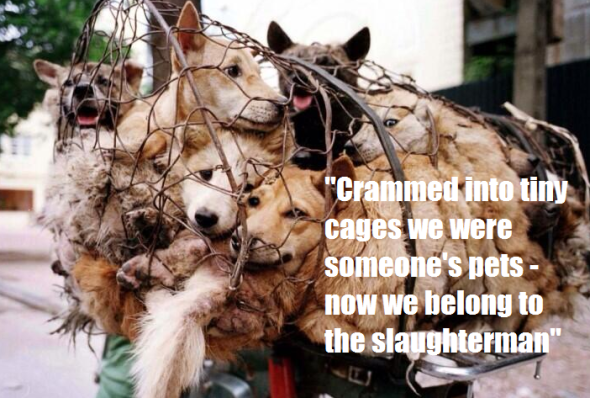 Its estimated that some 200,000 dogs are smuggled over the border from north-east Thailand into Vietnam. Its no pretty sight too, as much as 5-10 dogs can be crammed in tight wire mesh cages that then endure a hellish trip by road then river. The pain inflicted is horrific with countless dogs and cats suffering broken limbs or dying from over exposure or dehydration. When visiting Vietnam myself investigating the illegal wildlife trade seeing such sights in real life are by far more emotionally heart breaking than viewing on-line. One can shout and scream as much as one likes on-line or in the safe confines of their own home. Within dog meat markets though your emotions must be kept in tact.
Its estimated that some 200,000 dogs are smuggled over the border from north-east Thailand into Vietnam. Its no pretty sight too, as much as 5-10 dogs can be crammed in tight wire mesh cages that then endure a hellish trip by road then river. The pain inflicted is horrific with countless dogs and cats suffering broken limbs or dying from over exposure or dehydration. When visiting Vietnam myself investigating the illegal wildlife trade seeing such sights in real life are by far more emotionally heart breaking than viewing on-line. One can shout and scream as much as one likes on-line or in the safe confines of their own home. Within dog meat markets though your emotions must be kept in tact.
Dog meat traders that get a whiff of whom you are can and have attacked many investigative officers leaving them with serious injuries. When the dogs or cats arrive in Vietnam, the suffering doesn’t end there. A common belief is that stress and fear releases hormones that improve the taste of the meat, so the dogs are placed in stress cages that restrict their movement. Eventually, the dogs are either bludgeoned to death or have their throats cut in front of other dogs who are awaiting the same fate. In some cases, they’ve been known to be skinned alive. “Dogs are highly intelligent animals so if you kill a dog and you have a whole cage of dogs next to the one that’s being killed, those dogs that are going to be killed next know what’s going on,” Bendixsen said. According to animal rights groups, dog smugglers round up everything from family pets to Thailand’s ubiquitous strays — known as soi dogs — to sell the animals in Vietnam, or even as far away as China where a pedigree dog can fetch a premium price.
John Dalley of the Phuket-based Soi Dog Foundation estimates 98% of the dogs are domesticated and that some are even still wearing collars and have been trained and respond to commands. “You can see all types of pedigree animals in these captured Thai shipments — golden retrievers, long-haired terriers, you name it,” says Dalley. “Some are bought. Others are snatched from streets, temples, and even people’s gardens. “In the past, batches of stray dogs were traded for plastic buckets, but these days with demand soaring — especially in the winter months when dog meat is regarded as a “warming” food — a dog in Thailand can fetch up to $10. This figure jumps to around $60 once they are served up in restaurants in Vietnam. Dalley says pet dogs, in particular, are targeted because they are friendlier and easier to catch. Animal rights activists estimate that more than one million dogs are eaten each year in Vietnam; for the dog smugglers of the Mekong, business is booming. 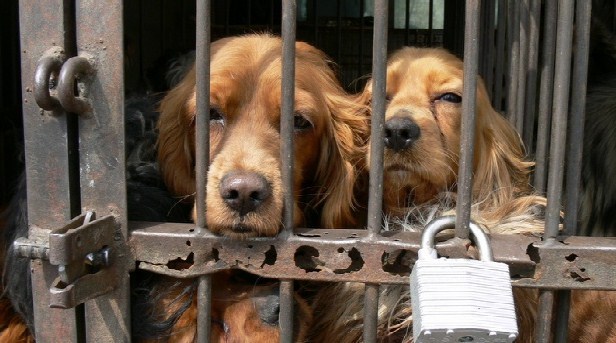 The following picture above was not taken in Vietnam but South Korea and depicts what John Dalley manager of Soi Dogs confirms with regards to pedigree dogs used in the meat trade.
The following picture above was not taken in Vietnam but South Korea and depicts what John Dalley manager of Soi Dogs confirms with regards to pedigree dogs used in the meat trade.
These two dogs are Golden Retrievers highly prized for the meat they were both a family pet. These pedigree dogs sell more than your non-pedigree of which smugglers search for on the streets in Vietnam, Thailand, Laos, South and North Korea. Pet “meat” trade may be booming in Vietnam and China however so is the bi-products of dogs. Daily Mail UK reported how dogs are also captured then killed to make GOLF GLOVES. Canine testicles are used to make these repulsive sports gloves of which demand is said to be high. ‘The skins would be bleached - some are then sent (by smugglers) to other countries to be made into gloves for playing golf,’ Lamai Sakolpitak, from a special police unit to suppress smuggling and the trade in animal parts, told AFP. But stopping what Capt Teerakiet calls a “billion-baht industry” is close to impossible under existing Thai law. It is illegal to steal domestic pets but not to round up stray dogs and pack them into cages. Animal cruelty is not banned, so a law is only actually broken when an attempt is made to smuggle the dogs out of Thailand. “On the scale of one to 10, I would say it’s a minus-one as far as the government’s concern for animal welfare goes,” said Roger Lohanan from the Thai Animal Guardians Association. As explained stopping this disgusting trade is going to take years rather than months. Pet meat consumption within Vietnam is “one” of the largest trades of non-legalised meat trade within Asia to date. Traditionalists will eat dog meat only on the lunar months while non-traditionalists will consume pet meat as a staple part of their diet. Just to give you some idea of how large this trade is I have included just a handful of (dog meat recipes) collated from authors around the globe.
Recipes include the following;
- Rựa Mận – Steamed dog meat with shrimp paste, rice flour, and lemongrass
- Giềng Me Mắm Tôm – Steamed dog in shrimp paste, galangal, and rice vinegar
- Thịt Chó Hấp – Steamed dog meat
- Thịt Chó Nướng – Grilled dog meat
- Dồi Chó – Dog sausage
- Chó Xào Sả Ớt – Fried dog in lemongrass and chili
- Canh Xáo Măng Chó – Bamboo and dog meat soup
Pet meat trade is vastly different to that of the legalised cattle meat trade. Dogs and cats are shown no mercy and as explained above are put through a brief hellish cycle of abuse, confinement and then slaughter of the most barbaric. Below is just one example of how a dog meat dish is prepared. Under no circumstances is this “food preparation” or “slaughter” even identical to that of the cattle meat trade and meat preparation. 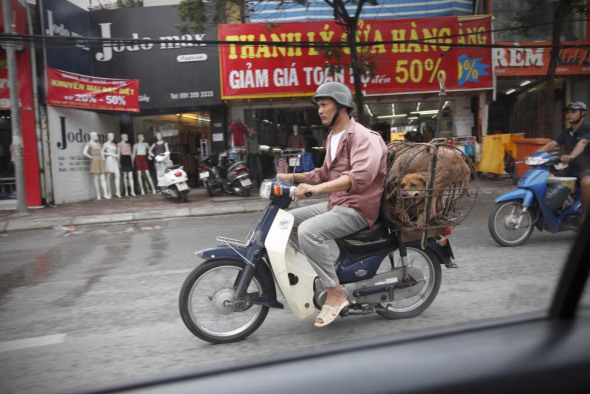
Trader and consumer;
Below is the sick - deprived and twisted method of dog slaughter and meat preparation Vietnam style straight from a street trader himself.
1. Strangle the dog from behind by surprise. Do this swiftly to prevent the dog from biting. Gag its mouth. Throw the dog in a waiting jeepney, tricycle or van. Drive as fast to avoid apprehension. When accosted though, bribe the barangay tanod or police with your crispy Php 500 bill. Should you bought the dog from a nearby area from an owner who is in dire need of money, put the dog in a sack. Carry the sack on your back.
2. Remove the dog from the sack. Tie the dog in a post. Do not hear its barks, cries and howls for dear life. Hit its head with a two-by-two inch piece of lumber with a nail at the end. Do this several times until it is dead.
3. Hang the lifeless dog on a tree branch or post upside down. Slit its throat. Place a basin underneath to catch blood. Sprinkle rice and salt on blood until it solidifies. (Blood of black dogs is a potent medicine against tuberculosis, says a folk belief in Africa.)
4. Burn the dog coat with a flame thrower. Release the lifeless dog from the post. Shave until its smooth white skin shows.
5. Slice to pieces. Wash.
6. Put the dog meat in a kawa or a big pan. Boil in vinegar for an hour.
7. Add a little water and sprinkle salt. Do not mix yet. Let it stand for a few more minutes.
8. Cook again in low, cooking fire. Add potatoes, soy sauce and sprinkle with black pepper.
9. Pour tomato sauce, tomato paste, yellow and green peas and garnish with plenty of laurel leaves.
10. Serve with plenty of ice-cold beers or gin.
Any activist that honestly believes the pet meat trade is completely identical to that of the “cattle meat trade” are very wrong. The only identical trait is that of death and even that is not quick nor clean. Below depicts what is called a “style” Michelin restaurant that is within China. Restaurants such as these are a common site all over Northern Vietnam and within Laos too. 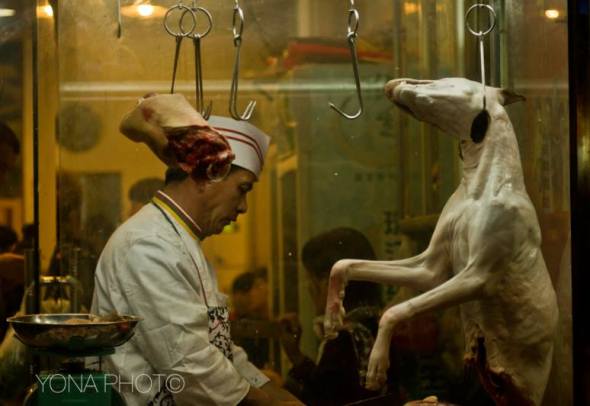 While the trade is illegal in Thailand, and authorities have made a number of raids involving thousands of dogs, dog traders claim the laws are unclear and have even mounted counter protests against a series of crackdowns. Smugglers are normally prosecuted under laws that prohibit the illegal trade and transportation of animals and, with no direct animal cruelty laws in Thailand, prosecutors attempt to charge smugglers with cruelty under Criminal Code laws. The Soi Dog Foundation and the Thai Society for the Prevention of Cruelty to Animals are fighting to change that and are currently working through the Department of Livestock Development to get an Animal Welfare Draft Law through the Thai Parliament. The reality, however, is that smugglers often receive light sentences of just a few months in jail. Animal activists also say thousands of impounded dogs — rescued from smugglers — that end up in quarantine centres sometimes find their way back onto the streets and in the dog meat circle again. “This is not about whether it is right or wrong to eat dog meat,” Dalley says. “It is about an illegal trade worth millions of dollars per year organized by criminals. The way in which these dogs are transported and, if they survive, killed, is horrific. “Some of the footage we receive is so horrific it’s too strong even for the media to run. It’s so inhumane … it’s quite literally hell on earth.”
While the trade is illegal in Thailand, and authorities have made a number of raids involving thousands of dogs, dog traders claim the laws are unclear and have even mounted counter protests against a series of crackdowns. Smugglers are normally prosecuted under laws that prohibit the illegal trade and transportation of animals and, with no direct animal cruelty laws in Thailand, prosecutors attempt to charge smugglers with cruelty under Criminal Code laws. The Soi Dog Foundation and the Thai Society for the Prevention of Cruelty to Animals are fighting to change that and are currently working through the Department of Livestock Development to get an Animal Welfare Draft Law through the Thai Parliament. The reality, however, is that smugglers often receive light sentences of just a few months in jail. Animal activists also say thousands of impounded dogs — rescued from smugglers — that end up in quarantine centres sometimes find their way back onto the streets and in the dog meat circle again. “This is not about whether it is right or wrong to eat dog meat,” Dalley says. “It is about an illegal trade worth millions of dollars per year organized by criminals. The way in which these dogs are transported and, if they survive, killed, is horrific. “Some of the footage we receive is so horrific it’s too strong even for the media to run. It’s so inhumane … it’s quite literally hell on earth.”
Cat meat horror - Vietnam; 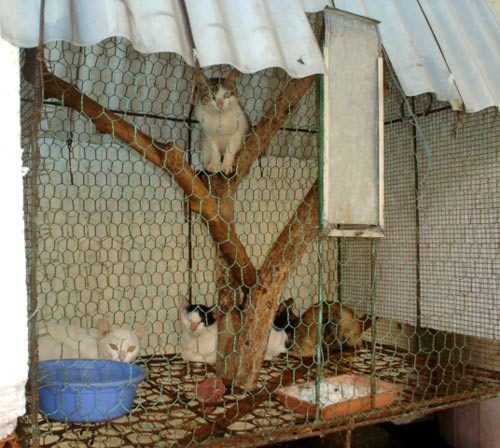 Picture above depicts a typical cat meat diner within Vietnam of which some 100,000 cats are annually butchered. Back in 2011 many Vietnamese indulged on cat meat being “year of the cat” cats really did suffer a horrific amount of abuse. Like eating dog meat, cat meat is considered a part of the country’s traditional cuisine.
Picture above depicts a typical cat meat diner within Vietnam of which some 100,000 cats are annually butchered. Back in 2011 many Vietnamese indulged on cat meat being “year of the cat” cats really did suffer a horrific amount of abuse. Like eating dog meat, cat meat is considered a part of the country’s traditional cuisine.
Groups of men (more so than women), seated on mats spend their evenings sharing plates of dog/cat meat and drinking alcohol since the meat is believed to raise libido. It is also said to bring luck and good fortune. Some restaurants in Hai Phong and Ha Long Bay even advertise cat meat hot pot as “little tiger”, and cats in cages can be seen meowing away in their cramped and filthy cages. However, Vietnamese aren’t the only ones eating man’s best friend or furry feline, some visitors to the country also enjoy the novelty of tasting and saying, Say No To Dog Meat.Net have documented on many Americans, Canadians, Aussies and Europeans not only liking the food torture but creating on-line cook books and media showing promoting the trade whilst activists and conservationists are trying to end this grisly food delicacy (please see video below).
Please feel free to “educate these irresponsible tourists here”
The good news is that recent Vietnamese opinion polls (2011 - 2012)– where animal welfare is a relatively new concept – suggest that the consumption of dogs and cats is losing popularity, especially with the younger generation. Although the consumption of cats increased from 2012, the big picture suggests that eating dogs and cats is slowly beginning to decline as Vietnam clamours to become an international country and aspires to rise to first-world standards. Cats are considered “little tigers” so eating them in Vietnam is supposed to give you the strength of a tiger. Again there is no evidence to even back such claims/beliefs up. 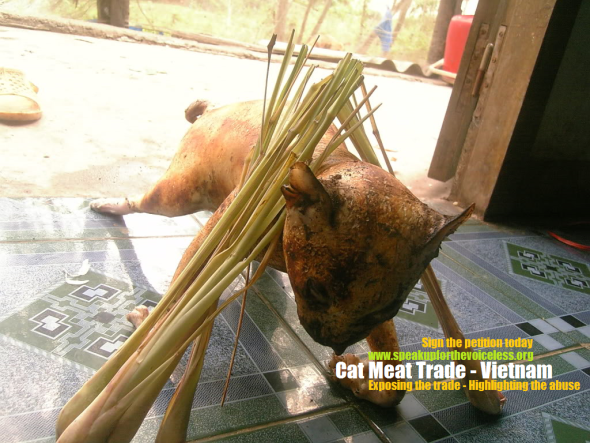 Say No To Dog Meat.Net quoted; By the time smuggled cats or dogs arrive in Vietnam, many have already died and almost all the barely surviving animals are covered in faeces and urine, as well as riddled with diseases, such as rabies. Dog and cat meat trade workers have high incidents of rabies, as they man-handle the animals, loading, unloading and brutally slaughtering them. In the northern province of Quang Ninh, Vietnam, authorities seized over 4,000 kilograms of live cats and cat meat last year, which had been smuggled into Vietnam. Provincial authorities said once the animals are smuggled in by boat at night, they are divided into smaller batches and delivered to restaurants and markets. To avoid detection, cat smugglers have begun killing cats before sneaking 50 kilogram packages of dead cats onto Vietnamese land. Nguyen Dang Truong, chief market manager of Quang Ninh Province, said cat smuggling from China is not new, but the illegal practice has never been carried out on such a large scale. The following is an excerpt from the Vietnamese Labourer News which details dog and cat parasitic worms that are a serious health threat to people who eat cats and dogs: “While both cats and dogs carry ascaris, a parasitic nematode worm that can grow in the human brain, liver and other internal organs, cats are the primary hosts of Toxoplasmosis gondii, a parasitic organism that can cause encephalitis (inflammation of the brain) and other neurological diseases.” “It can also affect the heart, liver, inner ears, and eyes. It can be fatal for people with weakened immune systems such as AIDS patients and pregnant women” “Cats also carry agents that can cause fungal skin diseases, typhoid fever, diarrhoea, and potentially fatal blood poisoning, they said, noting that infections are caused during digestion or through open wounds exposed to the slaughtering process.”
Say No To Dog Meat.Net quoted; By the time smuggled cats or dogs arrive in Vietnam, many have already died and almost all the barely surviving animals are covered in faeces and urine, as well as riddled with diseases, such as rabies. Dog and cat meat trade workers have high incidents of rabies, as they man-handle the animals, loading, unloading and brutally slaughtering them. In the northern province of Quang Ninh, Vietnam, authorities seized over 4,000 kilograms of live cats and cat meat last year, which had been smuggled into Vietnam. Provincial authorities said once the animals are smuggled in by boat at night, they are divided into smaller batches and delivered to restaurants and markets. To avoid detection, cat smugglers have begun killing cats before sneaking 50 kilogram packages of dead cats onto Vietnamese land. Nguyen Dang Truong, chief market manager of Quang Ninh Province, said cat smuggling from China is not new, but the illegal practice has never been carried out on such a large scale. The following is an excerpt from the Vietnamese Labourer News which details dog and cat parasitic worms that are a serious health threat to people who eat cats and dogs: “While both cats and dogs carry ascaris, a parasitic nematode worm that can grow in the human brain, liver and other internal organs, cats are the primary hosts of Toxoplasmosis gondii, a parasitic organism that can cause encephalitis (inflammation of the brain) and other neurological diseases.” “It can also affect the heart, liver, inner ears, and eyes. It can be fatal for people with weakened immune systems such as AIDS patients and pregnant women” “Cats also carry agents that can cause fungal skin diseases, typhoid fever, diarrhoea, and potentially fatal blood poisoning, they said, noting that infections are caused during digestion or through open wounds exposed to the slaughtering process.” 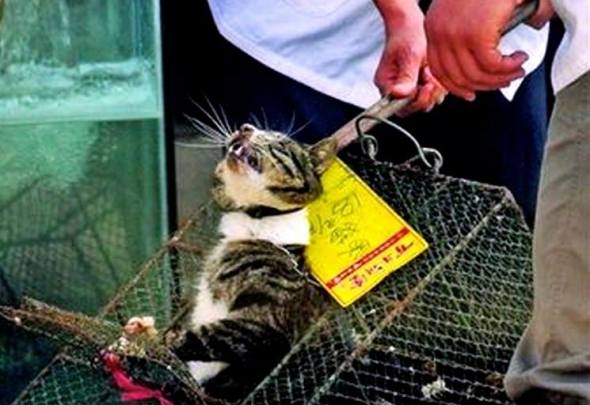 BACK IN MARCH 2014 - Thai police intercepted a pickup truck with six plastic cages filled with 90 cats in Nakhon Phanom Province in Thailand, on their way to Laos. The cats were ultimately destined for the tables of Vietnam, although the same trade exists even to a greater extent in China. The driver said he was paid approximately $65 to deliver the cats to a middleman on the Mekong River which marks the border between Thailand and Laos, and the middleman would transport them to Vietnam where they fetch high prices for their meat. The driver was charged with cruelty to animals and transporting livestock without a proper health check or permit, and the cats were sent to a quarantine station. Thai police believe this first case relating to cat smuggling for meat, is almost certainly linked to a local gang involved in smuggling dogs to Vietnam. Usually the perpetrators are lightly fined, released and try again another day.
BACK IN MARCH 2014 - Thai police intercepted a pickup truck with six plastic cages filled with 90 cats in Nakhon Phanom Province in Thailand, on their way to Laos. The cats were ultimately destined for the tables of Vietnam, although the same trade exists even to a greater extent in China. The driver said he was paid approximately $65 to deliver the cats to a middleman on the Mekong River which marks the border between Thailand and Laos, and the middleman would transport them to Vietnam where they fetch high prices for their meat. The driver was charged with cruelty to animals and transporting livestock without a proper health check or permit, and the cats were sent to a quarantine station. Thai police believe this first case relating to cat smuggling for meat, is almost certainly linked to a local gang involved in smuggling dogs to Vietnam. Usually the perpetrators are lightly fined, released and try again another day.
Public Fight Back; 2010-2014 we have seen quite a rise in public backlash both in China and Vietnam of which dog meat thief’s have been caught red handed of which subsequently were either beaten black and blue by angry baying crowds or recently within Vietnam three dog thief’s were beaten to death by angry locals. Whilst we do not support mob justice or violence we will copy the story here for you to read. International Animal Rescue Foundation, Say No To Dog Meat.Net and Speak Up for the Voiceless denounces all forms of violence. We ask all members of the public not to take the law into your own hands like those did (2010) within Vietnam. Sadly the mob that beat the dog meat traders to death were sentenced to three years in prison. This matter could have been handled differently however clearly shows the sheer frustration and anger that is now brewing within Asia. 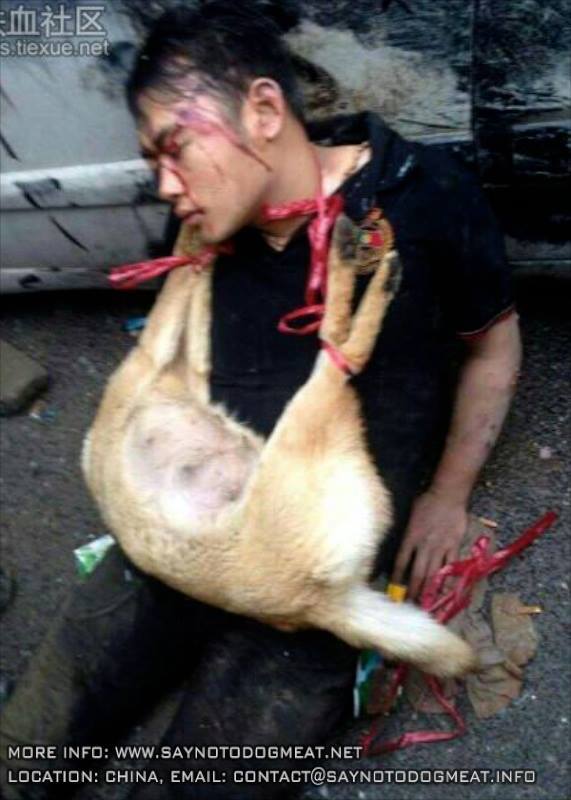
The story can be read hereto;
On June 10, Colonel Le Xuan Diep - Yen Thanh district police chief - said the incident occurred at around 5:30 am the same day in Village 3 of Tan Thanh commune, Yen Thanh district, Nghe An province. At the time, two dog thieves from Dien Lam commune, Dien Chau district drove a motorcycle to Village 3 of Tan Thanh commune to catch dogs. Several villagers detected the thieves after they caught a dog and put the animal into a sack. These people shouted to alarm others and chased after the thieves. Thousands of people flocked to the road to catch the thieves. The thieves were blocked and caught on the village road. After catching the thieves, hundreds of people beat them. Local police tried to rescue the thieves from angry people but they were prevented by extremists. It took them a long time to take the thieves to the hospital. Their motorcycle was burnt down. A thief died at 12.30pm in hospital while the remaining was seriously injured, said Colonel Le Xuan Diep. The case is being investigated by Yen Thanh district police. This is not the first time a dog thief was beaten to death. - Police later confirmed that ten people were sentenced to three years incarceration. Back in April 2014 the same more or less mob justice was inflicted in dog meat traders by baying angry crowds, this time in China. Two Chinese men were brutally beaten by villagers near Guilin city, after being caught stealing dogs for meat, reports The Daily Mail. The pair were caught stealing pets to sell for meat in restaurants. A villager caught the men in the act as they were stealing his dog–shortly after the thieves were bloodily beaten by the villager and his neighbors. The pair were dragged out of their car, beaten with bricks and bats. The car was heavily damaged by rocks as well. The thieves’ car contained three more dead, drugged dogs in the back of their trunk, which caused an even angrier and larger group of attackers, reports Jianxi Daily. Even though the two men were heavily injured, the Sanjiang villagers refused to give-up the dog thieves to the police officers. Instead, they continued to parade them through the streets and demanded a guarantee that they would get compensation for their dead animals. They demanded 50,000 RMB. Picture below depicts Chinese dog killers/traders handed down some rough justice from baying mobs;
Video below shows just how mob justice is dished out in Vietnam. Dog meat thief was in their eyes “taught a lesson”. Please note we do not support acts of violence against anyone or any living being.
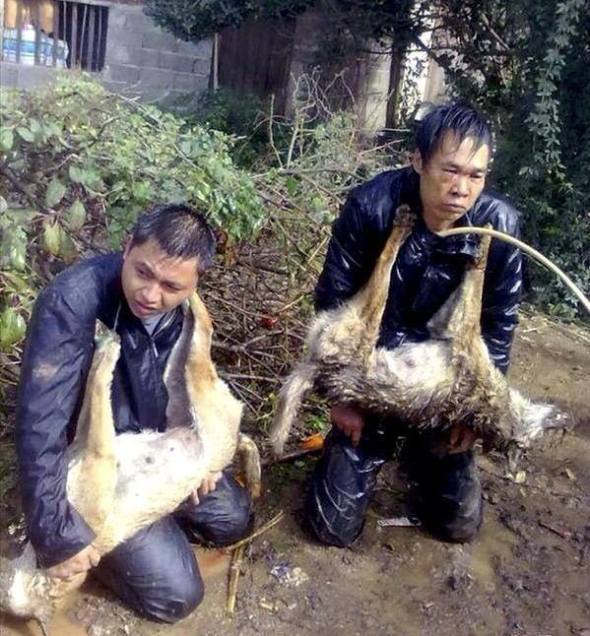 According to the Guilin City police report, the thieves would drive into small villages, listening for dogs barking and looking for unattended pets. After finding a decent sized animal, they would throw a peace of pre-drugged meat to the dog, after the drug took hold they would pick up the dog, hit it over the head in order to kill it, and put the carcass in the back of their car. Later they would sell the meat to restaurants and cafes. The situation was resolved only after the families of the two brutally beaten men turned up offering apologies, and promised to pay the compensation for the pets as requested.
According to the Guilin City police report, the thieves would drive into small villages, listening for dogs barking and looking for unattended pets. After finding a decent sized animal, they would throw a peace of pre-drugged meat to the dog, after the drug took hold they would pick up the dog, hit it over the head in order to kill it, and put the carcass in the back of their car. Later they would sell the meat to restaurants and cafes. The situation was resolved only after the families of the two brutally beaten men turned up offering apologies, and promised to pay the compensation for the pets as requested.
Pain;
Dogs and cats in pain often are quieter and attempt to hide and avoid contact with other dogs, cats and people. This behaviour can also include agitation and fear biting. These types of behaviours are general indicators of pain. The myth that dogs and cats do not feel pain is false. Viewing some of the animals on my trips to Vietnam crying and barking loudly, others sitting in sheer shock or depressed is surely a unique sign that the Vietnamese government must now put a bloody end to this gruesome and unethical food torture trade. Vocalization, if it is not a normal behaviour for the dog, can be a sign of pain. The sounds from the dog for example can be more subtle such as whining or even moaning. Injuries or pain to the legs can cause the dog to limp or have an altered way of walking. The dog will often react if the point of the injury is touched. In some cases the reaction can be violent. Many dogs transported in such small cramped cages often end up with broken limbs however are left to suffer. 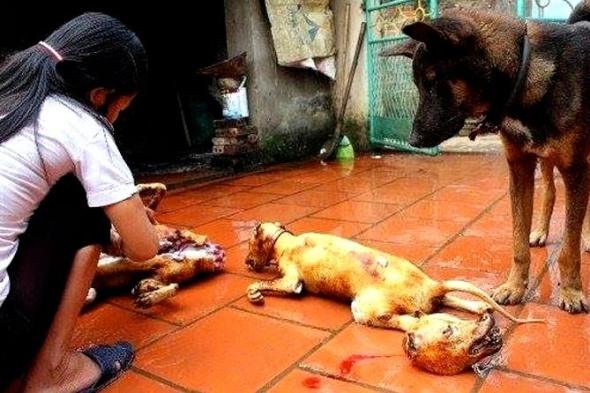 This is a violation of International law yet the trade still continues, dogs and cats suffer no matter what pain is inflicted to them during the process of capture and transportation. All the trader wants is money and while the consumer buys the demand increases. Many dogs within the meat trade will exhibit a lack of appetite while in pain. Even dogs in pain need nutrition however there is no such treatment given - after all there lives are not really important and are killed within hours or days. Any nutrition provided is forced using a steel or plastic tube rammed down the dogs throat of which the dog is then force fed to fatten the animal up. Hardly caring is it? Dogs in pain will show an increase in both breathing and heart rate. A normal heart rate for small dogs or puppies is between 120 and 160 beats per minute. The larger the dog the slower the heart rate, with some large dogs having a pulse of about 60 beats per minute. Normal respiration for a dog at rest is between 10 and 30 breaths per minute. Whilst we know this then we must continue to fight to ban the pet meat trade within Vietnam. Laws must be adopted, traders and traffickers arrested and farms closed down. There is no if’s nor buts the trade must end while there is vast evidence in the domain to prove there is no such medicinal properties within the meat of both dogs and cats, and pain is no myth either.
This is a violation of International law yet the trade still continues, dogs and cats suffer no matter what pain is inflicted to them during the process of capture and transportation. All the trader wants is money and while the consumer buys the demand increases. Many dogs within the meat trade will exhibit a lack of appetite while in pain. Even dogs in pain need nutrition however there is no such treatment given - after all there lives are not really important and are killed within hours or days. Any nutrition provided is forced using a steel or plastic tube rammed down the dogs throat of which the dog is then force fed to fatten the animal up. Hardly caring is it? Dogs in pain will show an increase in both breathing and heart rate. A normal heart rate for small dogs or puppies is between 120 and 160 beats per minute. The larger the dog the slower the heart rate, with some large dogs having a pulse of about 60 beats per minute. Normal respiration for a dog at rest is between 10 and 30 breaths per minute. Whilst we know this then we must continue to fight to ban the pet meat trade within Vietnam. Laws must be adopted, traders and traffickers arrested and farms closed down. There is no if’s nor buts the trade must end while there is vast evidence in the domain to prove there is no such medicinal properties within the meat of both dogs and cats, and pain is no myth either.
Dogs are routinely snatched within Vietnam by traffickers or opportunistic snatchers. Please view the video below.
Concluding;
The pet meat trade whether in Asia or Africa must come to an end. The only identical trait to both the cattle meat trade and the pet meat trade is that of death. However the brutal deaths, trafficking and abuse is non-identical to that of cattle within the “regulated meat industry”. Evidence past and present clearly shows there is potential for diseases and new virus’s to emerge of which talking Africa for example has already began. Ebola Haemorrhagic Fever although not directly related to dogs, evidence from the World Health Organisation and Scientific Bodies have shown the Ebola virus can be passed from dog to human. Dogs act as a host animal. Within West Africa dogs are mainly strays that wander the dense forest and rural communities in search of foods. When coming in to contact with carrion that is infested with Ebola the animal can then carry this directly into a community. Dogs that then come into contact with humans of which have blood on their fur, noses or mouths can then easily pass the virus on resulting in a very short but extremely painful death with only 10% of Ebola victims actually surviving. There is no treatment nor any cure and should for example any Ebola victim travel out of Africa into Europe or America within the incubation period the possible for disease outbreak is worrying. Fortunately this has yet to happen.
Please read more here for further information. https://speakupforthevoiceless.org/2014/04/02/dog-meat-trade-ebola/ and here http://saynotodogmeat.net/food-hygiene-disease/
International Animal Rescue Foundation Africa and Asia, Speak Up for the Voiceless and Say No To Dog Meat.Net are currently lobbying the Vietnamese and Thailand Government calling for the pet meat trade to be firmly banned. You can join us in our’s and others quests to kill the trade by signing and sharing the petitions below. We politely ask too that you lobby any film production companies that you know to highlight and show in full the Soi Dog Shadow Trade of which the film is listed above.
Thank you for taking the time to read.
Chief Environmental Officer Malaysia
Chief Environmental and Botanical Officer Africa
Chief Executive Officer
International Animal Rescue Foundation is not a charity however will from time based on animal and environmental needs lobby the public for both verbal and finical support of which is 100% regulated and legitimate. Speak Up for the Voiceless our main Animal and Environmental News Column and Environmental News and Media are part and parcel to our legitimate environmental company that undertake ground investigations and publish news within the Animal Rights and Environmental Activism domain. Say No To Dog Meat.Net is run by our Environmental Officer and that of Donna Armes and Ms Brown. Say No To Dog Meat.Net has no affiliation with the British Charity World Protection for Cats and Dogs in the Meat Trade or its campaign No To Dog Meat. For further information on how you can help us or just to speak to one of our team or if you have any concerns you’d like to submit or raise please feel free to email us here at - [email protected] or [email protected] We do exactly what it says on the tin and take great pride in our work both at ground level or on-line.



Thank you for your reply, should it merit a response we will respond in due course. This site is owned by International Animal Rescue Foundation and moderation is used.